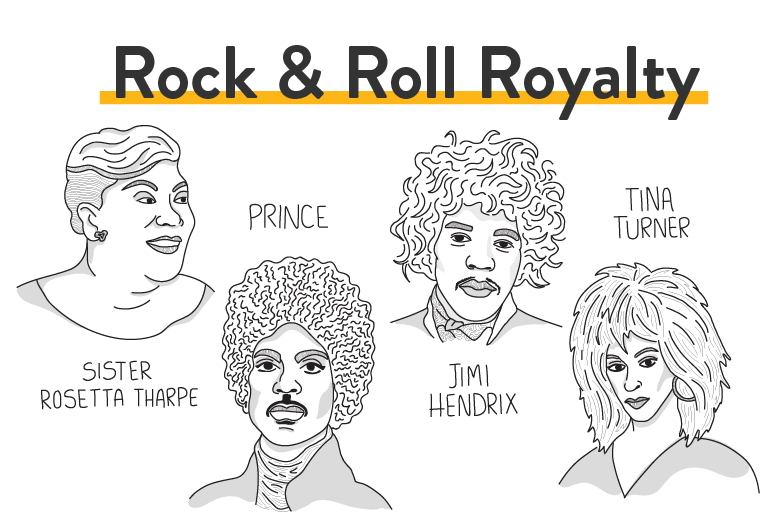In the early 1950’s, a brand new sound exploded onto the American music scene. Made famous by Cleveland radio DJ Alan Freed in 1951, the term “rock and roll” came to describe a new type of music that teenagers all over the United States were listening to. While parents of the decade were fans of crooners like Frank Sinatra and Perry Como, their children were dancing to a brand new beat.
A Very Brief History of Rock and Roll
While it has its roots in gospel and country – Rock and Roll’s most direct influence is the Blues, a style of music that originated on the plantations in the Deep South in the early 19th century. Enslaved people blended the sounds and rhythms of their homelands far away in songs of resistance. From the Blues came Rhythm & Blues (R&B), and as R&B became more uptempo – it evolved into Rock and Roll.
In the late 1940’s, many southern African Americans moved to the bustling big cities of the north. Part of the Great Migration, they were searching for a safer life and fleeing Jim Crow laws in many states. Although they left their homes behind, they brought the dance-able sounds of R&B and Rock and Roll with them, and this new music immediately struck a chord with suburban teenagers.
Teenagers were instrumental to the rise of Rock and Roll in the United States. This new generation of young people was much larger than any in recent memory, and the prosperity of the time gave teens money to spend on records. Music executives saw an opportunity to capitalize off the sudden popularity of this youthful sound, but the racism of the era made it nearly impossible for African American artists to air on mainstream radio or secure record deals. It wasn’t long before label owners sought out White performers to cover songs by Black artists, paving the way for musicians like Elvis Presley and Buddy Holly to build careers from the songs of other artists.
With this in mind, it’s very important to recognize that without the artistic contributions of African American performers, Rock and Roll would not exist as we know it today.
Subscribe for updates, content & free resources!
Notable Names:
We’re excited to explore the heritage of some of Rock and Roll’s pioneers in this blog post. These are just a FEW of the innovative men and women who have contributed to its rich and enduring history.
Sister Rosetta Tharpe
“My career is one long Sister Rosetta Tharpe impersonation” – Chuck Berry
Sister Rosetta Tharpe was born in Cotton Plant, Arkansas – where a stretch of highway was renamed for her in 2017. She mastered the guitar by age six and attended church conventions with her mother, Katie Bell Nubin. She spent her early years performing in churches with an evangelist group who traveled around the United States. Her big break came in 1938 with a record called “Rock Me.” It made her a star through the 1940’s and she toured the nation singing gospel music to the accompaniment of her own electric guitar. Sister Rosetta played loudly and joyfully, with a skill that surpassed and amazed many of her male contemporaries.
During her career, Tharpe broke a lot of boundaries.
- She was a female guitarist in a male-dominated genre in a time where female musicians rarely took center stage.
- She was the first gospel performer to play Harlem’s Apollo Theater and the whites-only Cotton Club.
- Her 1945 recording “Strange Things Happening Every Day” is considered to be the first gospel song to cross over to the R&B charts of the time. It eventually reached Number Two and became an early model for that distinct rock and roll sound.
In 1951, twenty-five thousand fans paid to attend her on-stage wedding at Griffith Stadium in Washington DC. Other Rock legends like Elvis Presley, Carl Perkins and Jerry Lee Lewis modeled their performances after her unique style. Johnny Cash even called her his favorite singer and biggest inspiration! It’s clear to see that Tharpe may be the Mother of Rock’n Roll who gave its founding fathers their ideas. If you’d like to learn more about her fascinating legacy, we recommend this book.
Jimi Hendricks
“Music doesn’t lie. If there is something to be changed in this world, then it can only happen through music.” – Jimi Hendricks
Widely considered one of the greatest guitarists of all time, Jimi was born Johnny Allen Hendrix on November 27, 1942 in Seattle, Washington. His father later changed his name to James Marshall. Hendrix’s childhood was a rough one, but he displayed a passion for music from early on. Rumor has it that young Jimi would strum a broom like a guitar, which inspired his father, Al, to buy his son an acoustic guitar at 16 and an electric one the following year.
After an honorable discharge from the US Army in 1962, Jimi began performing under the stage name Jimmy James as a session musician for B.B. King, Sam Cooke, Little Richard and others. He then went on to form The Jimi Hendricks Experience with bassist Noel Redding and drummer Mitch Mitchell. Hendrix became a global superstar after his iconic performance at the Woodstock festival in 1969, opening with his protest rendition of “The Star-Spangled Banner.”
Sadly, on September 18, 1970, Hendrix died. He was only 27 years old. Even decades after his death, Hendricks’ talent lives on through the inspiration he provided to aspiring rock musicians. In fact, Prince was among the many, many artists who were profoundly influenced by Hendricks’ career.
Prince
“He was a great musician. He loved music. He loved playing his instrument. The times that we did jam together were amazing with all of the various people that he would bring together, and most of all he brought all the various cultures together. He could play classical music if he wanted to. He could play jazz if he wanted to, he could play country if he wanted to. He played rock, you know, he played blues. He played pop. He played everything… And [he was] very cognizant of what his responsibility was as a musician and a human being.” – Stevie Wonder on Prince
There is almost too much to say about The Purple One. Prince’s career spans across multiple decades and genres, contains 16 Platinum records, 8 worldwide number one albums, 4 films, and close to 1000 (released and unreleased) songwriting credits.
Born Prince Rogers Nelson on June 7, 1958, in Minneapolis, Minnesota – Prince’s parents were both performers. His father, John Nelson, was a musician whose stage name was Prince Rogers, and his mother, Mattie Shaw, a jazz singer who performed with the Prince Rogers Band.
That strong musical influence created the foundation for Prince to become a once-in-a-lifetime artist. Prince could play many instruments and on the notes for his debut album, For You , he is credited as playing ALL of the 27 instruments on the recordings. That’s right, 27 instruments, which include, but are not limited to: electric guitar, acoustic guitar, bass, bass synth, singing bass, electric piano, acoustic piano, mini-Moog, poly-Moog, Arp string ensemble, clavinet, drums, slapsticks, bongos, congas, and finger cymbals.
Although his performances, career and image were never without controversy, Prince’s authentic and unique vision inspired countless artists to embrace their true selves. When he passed away suddenly in 2016, the outpouring of love from his fans was overwhelming. He is still very much missed today.
Tina Turner
My legacy is that I stayed on course… from the beginning to the end, because I believed in something inside of me.
Tina Turner
Tina displayed a gift for singing from a very young age. She sang in her church choir as a child, and performed in nightclubs when she was a teenager. In the late Fifties, she met and began singing with Ike Turner, alongside him, she rose to fame as the fiery star of the Ike and Tina Turner Revue. The duo had success for close to 15 years, largely due to Tina’s flamboyant, high energy performances. However, Ike and Tina’s personal relationship was very troubled. In 1976 Tina left Ike, and in 1978 their divorce was finalized.
Thankfully, Tina went on to a hugely successful solo career. Her U.S. breakthrough came with 1984’s Private Dancer, which sold more than five million albums. Foreign Affair, released in 1989, sold even more copies.
Tina now lives in Switzerland with her new husband. Recognition for her triumphant career is ongoing. Tina was even bestowed with a Lifetime Achievement Award at the 2018 Grammys.
Up Next, Pop Divas!
Tina is a great spot to end this post because later this week, we’ll be diving into the exciting contributions of African American Pop Divas. Stay tuned for a post that highlights the careers of Whitney Houston, Aretha Franklin, Alicia Keyes and Beyonce.
In the meantime, remember to check out our special AAMAM Spotify Playlist!




